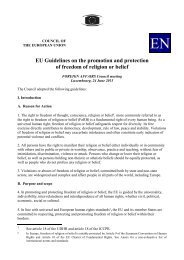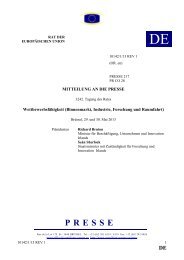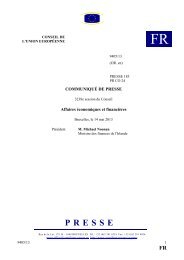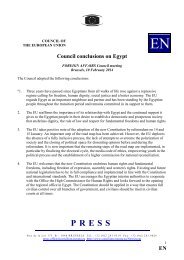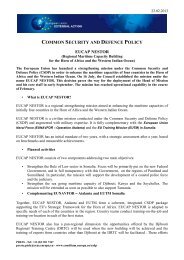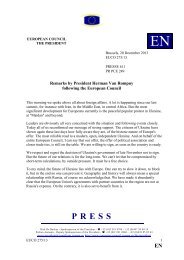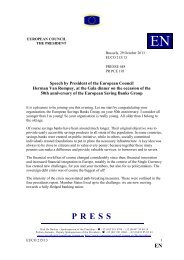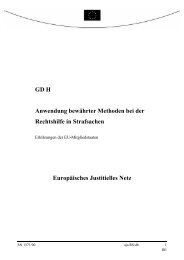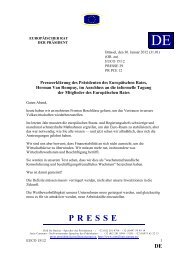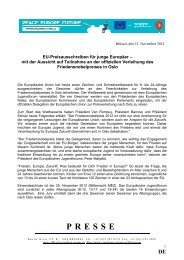14508/09 ADD 1 PL/vk 1 DG G COUNCIL OF THE ... - Europa
14508/09 ADD 1 PL/vk 1 DG G COUNCIL OF THE ... - Europa
14508/09 ADD 1 PL/vk 1 DG G COUNCIL OF THE ... - Europa
You also want an ePaper? Increase the reach of your titles
YUMPU automatically turns print PDFs into web optimized ePapers that Google loves.
It should be emphasised that the high availability of childcare in this age group is to a large extent<br />
due to the inclusion of official pre-school arrangements. In this age category we also find that many<br />
parents have to rely on other childcare arrangements or a combination of formal and other<br />
arrangements (see figure 4.6.6). In the Nordic countries formal childcare – together with parental<br />
care – seems to cover the needs in both age categories, while in Slovenia, the Netherlands, Hungary<br />
and Cyprus, parents rely heavily on other child care arrangements.<br />
Indicator 4: This indicator is the only one proposing a qualitative approach based on the MS<br />
implementing policies in favour of work-life balance. The evaluation report drawn up by the French<br />
Presidency relied on work by experts in the European Commission's gender and employment<br />
network, who produced Reconciliation of work and family life (Plantenga and Remery 2006) based<br />
on national reports. In this Beijing +15 follow-up report reference is made only to that publication<br />
and to the summary presented by the French Presidency for further information.<br />
Indicator 5: Harmonised data covering this indicator for the EU-countries are not available.<br />
However, data taken from different sources are presented in the French Presidency report which<br />
gives some information regarding the situation in some of the EU15 countries, in particular help for<br />
aged persons who lose their self-sufficiency. The lack of data is indicative of the weak institutional<br />
provision for such care. Available data seem to show that recourse to institutions in most countries<br />
is low. In France 1 %, Austria 2 %, UK 4 %, Netherlands 5 % and Sweden 8 % of dependent<br />
persons live in institutions. Other data show that 96 % of dependent elderly people are supported by<br />
their families in France, 95 % in Spain, 87 % in Italy, 83 % in Germany and 79 % in the<br />
Netherlands and Sweden. The involvement of children is higher when the parent has no spouse.<br />
An investigation of the dependent elderly in the newer MS show that they have not yet been<br />
confronted with the problem of elderly dependency on the same scale as in EU15 countries (Mette<br />
2006). The provision of care for the dependent elderly appears to be better in Malta and Slovenia<br />
than in other countries. They have a high number of long-term care facilities and nurses per<br />
inhabitant. Poland also appears to be better placed than most of the other newer MS, spends a<br />
considerable proportion of its GDP on the aged and has a higher number of long-term care beds.<br />
The three Baltic States are distinguishable from the others in that the GDP share allocated to the<br />
dependent elderly is low despite the fact they are expected to be among the countries with the oldest<br />
population in coming decades.<br />
<strong>14508</strong>/<strong>09</strong> <strong>ADD</strong> 1 <strong>PL</strong>/<strong>vk</strong> 89<br />
ANNEX <strong>DG</strong> G EN



